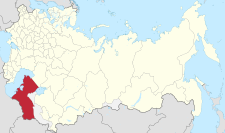| Transcaspian Oblast Закаспійская область | |
|---|---|
| Oblast | |
 Coat of arms Coat of arms | |
 Location in the Russian Empire Location in the Russian Empire | |
| Country | Russian Empire |
| Governorate-General | Turkestan |
| Established | 1881 |
| Abolished | 1921 |
| Capital | Askhabad |
| Area | |
| • Total | 605,150.93 km (233,650.08 sq mi) |
| Population | |
| • Total | 382,487 |
| • Density | 0.63/km (1.6/sq mi) |
The Transcaspian Oblast, or simply Transcaspia, was an oblast of the Russian Empire and early Soviet Russia to the east of the Caspian Sea during the second half of the 19th century until 1924.
It was bounded to the south by Iran's Khorasan Province and Afghanistan, to the north by the former Russian province of Uralsk, and to the northeast by the former Russian protectorates of Khiva and Bukhara. Part of Russian Turkestan, it corresponded roughly to the territory of present-day Turkmenistan and southwestern Kazakhstan.
The name of the oblast (literally, 'Beyond Caspian') is explained by the fact that until the construction of the Trans-Aral Railway in the early 20th century the easiest way to reach this oblast from central Russia (or from Russian Transcaucasia) was across the Caspian Sea, by boat from Astrakhan or Baku.

History
| Part of a series on the |
|---|
| History of Turkmenistan |
 |
| Antiquity |
| Middle Ages |
| Early modern history |
| Modern history |
| Related historical regions |
|
|
Transcaspia was conquered by Russia in 1879–1885, in a series of campaigns led by Generals Nikolai Lomakin, Mikhail Skobelev, and Mikhail Annenkov. The construction of the Transcaspian Railway was started from the shores of the Caspian in 1879 in order to secure Russian control over the region and provide a rapid military route to the Afghan border. In 1885 a crisis was precipitated by the Russian annexation of the Panjdeh oasis, to the south of Merv, which nearly led to war with Britain, as it was thought that the Russians were planning to march on to Herat in Afghanistan. Until 1898 Transcaspia was part of the Governor-Generalship of the Caucasus Viceroyalty administered from Tiflis, but in that year it was made an oblast of Russian Turkestan governed from Tashkent. The best known military governor to have ruled the region from Ashkhabad was probably General Kuropatkin, whose authoritarian methods and personal style of governance made the province very difficult for his successors to control. Consequently, the administration of Transcaspia became a byword for corruption and brutality within Russian Turkestan, as Russian administrators turned their districts into petty fiefdoms and extorted money from the local population. These abuses were fully exposed by the Pahlen Report of 1908–1910.
During the revolutionary period of 1917 to 1919, parts of Transcaspia were briefly occupied by British Indian forces from Meshed. The oblast was one of the last centres of Basmachi resistance to Bolshevik rule, with the last of the rebellious Turkmen fleeing across the border to Afghanistan and Iran in 1922 and 1923.
Demographics
As of 1897, 382,487 people populated the oblast. Turkmens constituted the majority of the population, and significant minorities were Kazakhs and Russians. The total Turkic-speaking population was 328,059 (85.8%).
Ethnicity
Overall
According to the 1897 Russian census, the ethnic groups by population were:
| Ethnic group | Population | Percentage |
|---|---|---|
| Turkmens | 248,651 | 65% |
| Kazakhs | 74,225 | 19.4% |
| Russians | 27,942 | 7.3% |
| Persians | 8,015 | 2.1% |
| Total | 382,487 | 100% |
By okrug
Ethnic groups by percentage of the Transcaspian population according to the 1897 census:
| Okrug (district) | Turkmens | Kazakhs | Russians | Persians |
|---|---|---|---|---|
| Ashgabat | 73.1% | - | 12.8% | 3.3% |
| Krasnovodsk | 62.4% | 19.3% | 9.7% | 3.4% |
| Mangyshlak (centred on Fort-Aleksandrovsk) | 4% | 93% | 2.6% | - |
| Merv | 88% | - | 4.5% | 0.8% |
| Tejen | 82% | - | 7.9% | 4.1% |
| Total | 65% | 19.4% | 7.3% | 2.1% |
Ethnic groups by population in Transcaspia according to the 1897 census:
| Okrug | Turkmens | Kazakhs | Russians | Persians |
|---|---|---|---|---|
| Ashgabat | 67,443 | 22 | 11,763 | 3,206 |
| Krasnovodsk | 33,529 | 10,394 | 5,222 | 1,822 |
| Mangyshlak | 2,767 | 63,795 | 1,795 | 6 |
| Merv | 104,980 | 11 | 5,321 | 964 |
| Tedjen | 39,932 | 3 | 3,841 | 2,017 |
| Total | 248,651 | 74,225 | 27,942 | 8,015 |
Notes
- Russian: Закаспі́йская о́бласть, romanized: Zakaspíyskaya óblastʼ
- Russian: Зака́спія, romanized: Zakáspiya
References
- G.N. Curzon Russia in Central Asia (London: Longmans) 1889 pp1-15
- Alexander Morrison (2008-09-01). Russian Rule in Samarkand 1868-1910: A Comparison with British India. OUP Oxford. p. 20. ISBN 978-0-19-954737-1.
- Richard A. Pierce Russian Central Asia 1867-1917 (Berkeley: University of California Press) 1960 pp88-9
- ^ "Справочник статистических показателей" [Handbook of statistical indicators]. Demoscope Weekly – Application (in Russian).
- Kropotkin, Peter Alexeivitch (1888). "Transcaspian Region" . Encyclopædia Britannica. Vol. 23 (9th ed.). pp. 511–513.
- Kropotkin, Peter; Bealby, John Thomas (1911). "Transcaspian Region" . In Chisholm, Hugh (ed.). Encyclopædia Britannica. Vol. 27 (11th ed.). Cambridge University Press. pp. 170–172.
| Turkmenistan articles | |||||
|---|---|---|---|---|---|
| History | |||||
| Geography | |||||
| Politics | |||||
| Economy | |||||
| Society |
| ||||
37°57′00″N 58°23′00″E / 37.9500°N 58.3833°E / 37.9500; 58.3833
Categories: